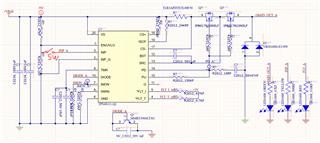Other Parts Discussed in Thread: TPS48111Q1EVM
Tool/software:
Hi,
I am designing a battery-powered system that requires a hot-swap controller. I have experience using the TPS4811-Q1 as a MOSFET switch, and I would like to know if it can also be used as a hot-swap controller.
The required functions, such as inrush current limiting and overcurrent protection (OCP), have been tested and verified on the MOSFET switch. However, I have a few concerns:
- Will there be any issues if voltage is applied simultaneously to the VIN and INP pins?
- Will there be any issues if voltage is applied to the INP pin first?
- Could there be any risk of failure or damage in transient situations, such as when the battery is removable?
I’ve attached a circuit diagram below for reference. Please let me know if this configuration is suitable for use as a hot-swap controller.
Thank you for your support!


